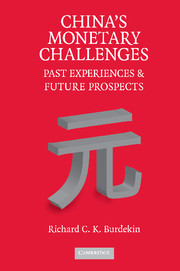Book contents
- Frontmatter
- Contents
- Preface
- Introduction: China Today and Lessons from the Past
- PART I CHINA'S EXCHANGE RATE REGIME AND MONETARY POLICY
- 1 The Renminbi–US Dollar Exchange Rate Controversy
- 2 China's Reserve Buildup and Global Imbalances
- 3 Combatting Inflation and Deflation
- 4 People's Bank of China Policymaking and External Pressures
- PART II THE IMPORTANCE OF INTERNATIONAL FACTORS, PAST AND PRESENT
- PART III THE PEOPLE'S REPUBLIC'S ROLE WITHIN GREATER CHINA AND ASIA
- 10 Conclusions and Future Prospects for the Renminbi
- References
- Author Index
- Subject Index
3 - Combatting Inflation and Deflation
Published online by Cambridge University Press: 06 July 2010
- Frontmatter
- Contents
- Preface
- Introduction: China Today and Lessons from the Past
- PART I CHINA'S EXCHANGE RATE REGIME AND MONETARY POLICY
- 1 The Renminbi–US Dollar Exchange Rate Controversy
- 2 China's Reserve Buildup and Global Imbalances
- 3 Combatting Inflation and Deflation
- 4 People's Bank of China Policymaking and External Pressures
- PART II THE IMPORTANCE OF INTERNATIONAL FACTORS, PAST AND PRESENT
- PART III THE PEOPLE'S REPUBLIC'S ROLE WITHIN GREATER CHINA AND ASIA
- 10 Conclusions and Future Prospects for the Renminbi
- References
- Author Index
- Subject Index
Summary
Beijing is preparing to step on the brakes – Chinese style. The 10 per cent annualized growth in first quarter domestic product came on the back of surging liquidity. Banks lent $137bn in the first quarter, about half the amount targeted for the whole year. Monetary tightening is overdue…China has opted for administrative measures and is likely to do so again. Possible actions include stricter bank reserve and lending rules and limiting land supply…
(Financial Times, April 26, 2006a, p. 16)Introduction
For much of its existence, the People's Republic of China was essentially free of open inflation. Rigid controls kept official prices of many goods virtually unchanged for decades before economic reforms began in 1978. Limited inflationary pressures emerged after 2002 in the face of rising capital inflows and growing pressure for renminbi appreciation, as discussed in Chapter 1. However, Chinese authorities previously had to confront much more severe upward spikes in inflation in both 1988–1989 and 1993–1995. Inflation peaked at over 24% in 1994 before falling back to single digits in 1996 and less than zero in 1998. By 1998, the government's concern clearly shifted to the slowing growth rate of the economy and the weaknesses in the nation's banking system. The increased government expenditures aimed at boosting growth and recapitalizing the banks helped end China's deflation episode but also set the stage for new inflation worries in the early twenty-first century.
- Type
- Chapter
- Information
- China's Monetary ChallengesPast Experiences and Future Prospects, pp. 55 - 75Publisher: Cambridge University PressPrint publication year: 2008



